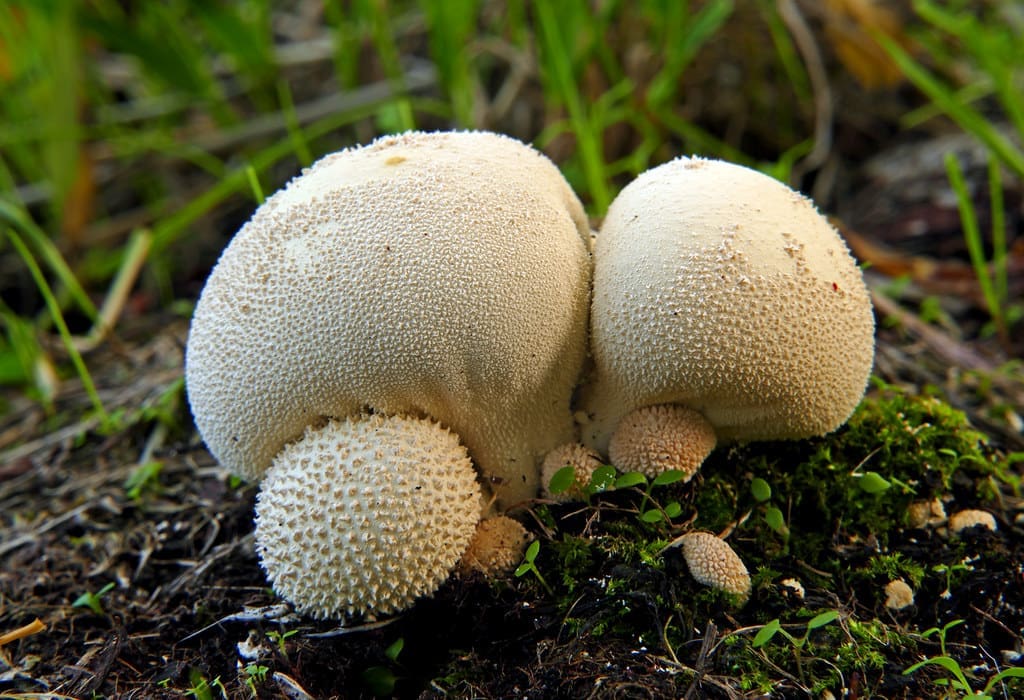
Bovista gigantea
Latin name: Bovista gigantea
Short name: Bov
Common name: Puff-ball Fungus | Giant Puffball | Meadow Puffball | Lycoperdon
Primary miasm: Psoric Secondary miasm(s): Syphilitic
Kingdom: Fungi
Family: Agaricaceae
- Symptomatology
- Remedy Information
- Differentiation & Application
Prepared from the dried spores of the puff-ball fungus, a large Basidiomycete found in meadows, pastures, and open woods, particularly in Europe and North America. In its fresh state, the interior is white and edible; as it matures, the interior turns into a mass of dry spores, which disperse in clouds when pressed. Inhalation of large quantities of spores in crude form can produce marked respiratory and constitutional symptoms.
Edible when young and white; historically used by country folk as a styptic to stop bleeding (spores applied to wounds) and as a kind of tinder for starting fires.
Proved by Franz in 1828, later incorporated into Hahnemann’s Chronic Diseases and Allen’s Encyclopaedia of Pure Materia Medica. Also clinically enriched by Clarke, Kent, and Hering.
- Skin & Connective Tissue: Urticaria, eczema, excoriation.
- Circulatory System: Tendency to haemorrhage, bleeding diathesis.
- Female Reproductive System: Profuse menses, prolonged menstrual flow.
- Nervous System: Numbness, awkwardness of movement.
- Mouth & Throat: Aphthous ulcers, burning sensations.
- Gastrointestinal Tract: Diarrhoea before and during menses.
- Gentle motion (relieves stiffness) [Clarke].
- Open air (lessens confusion and headache).
- Rest after exertion.
- Morning on waking.
- Warmth of bed (itching, skin irritation).
- Before and during menses (worsens weakness, diarrhoea).
- Touch and pressure on skin eruptions.
- Overexertion, especially manual work.
- Sepia – Menstrual irregularities with bearing-down; Sepia more indifferent emotionally, less clumsy physically.
- Lachesis – Premenstrual aggravations with congestion; Lachesis worse after sleep, more loquacious.
- Cyclamen – Menstrual troubles with vision disturbance; Cyclamen has aversion to open air, while Bovista is better in it.
- Complementary: Sepia, Calcarea carbonica.
- Antidotes: Coffea, Camphor.
- Follows well: Sulphur in chronic skin conditions.
Bovista centres on awkwardness, easy bleeding, and skin excoriation — a patient whose symptoms often revolve around the menstrual cycle. The clumsiness is not only mental but motor, leading to mishaps and injuries, which then bleed easily and heal slowly. The skin is delicate and easily irritated, and the constitution appears soft, pale, and sensitive.
- Very effective in skin eruptions that worsen before menses.
- Useful for women with profuse, prolonged periods accompanied by diarrhoea.
- Can be considered for athletes or workers with skin chafing and excoriation.
- Beneficial in awkward, clumsy children with delicate skin.
Mind:
- Awkwardness, drops things.
- Confusion on waking.
- Irritability before menses.
Head:
- Heaviness of head in morning.
- Constriction of forehead.
Eyes:
- Flickering vision.
- Heaviness of lids.
Stomach:
- Aversion to warm food in morning.
- Nausea on waking.
Skin:
- Excoriation from friction.
- Urticaria before menses.
- Wounds bleed easily.
Extremities:
- Numbness of hands.
- Trembling after exertion.
Generalities:
- Better in open air.
- Worse before menses.
Hahnemann S. – Chronic Diseases: Original proving symptoms, morning aggravations.
Allen T.F. – Encyclopaedia of Pure Materia Medica: Detailed proving records.
Clarke J.H. – Dictionary of Practical Materia Medica: Clinical notes, skin sphere.
Kent J.T. – Lectures on Materia Medica: Mental and menstrual aspects.
Hering C. – Guiding Symptoms: Skin excoriation, awkwardness.
Lippe A. von – Keynotes: Clumsiness before menses.
Boericke W. – Pocket Manual: Summary indications.
Boger C.M. – Synoptic Key: Premenstrual aggravations.
Nash E.B. – Leaders in Therapeutics: Menstrual diarrhoea.
Farrington E.A. – Clinical Materia Medica: Comparative menstrual remedies.
